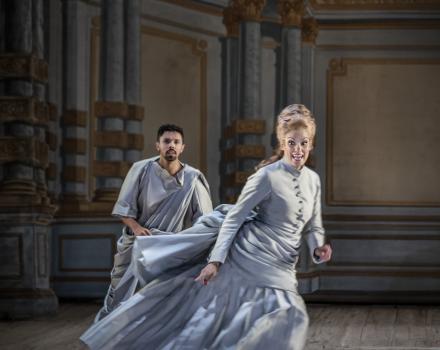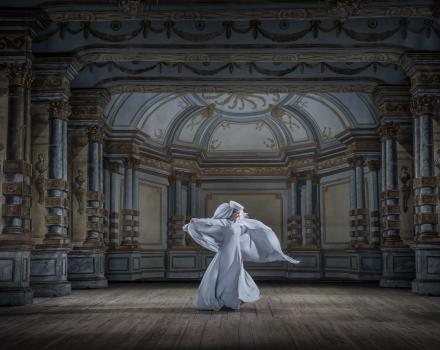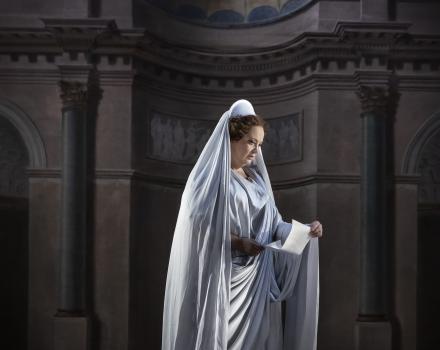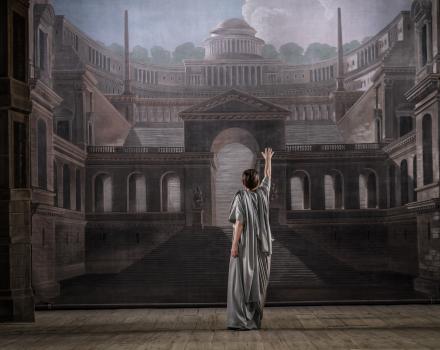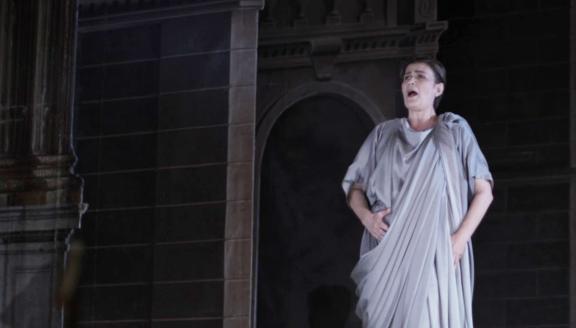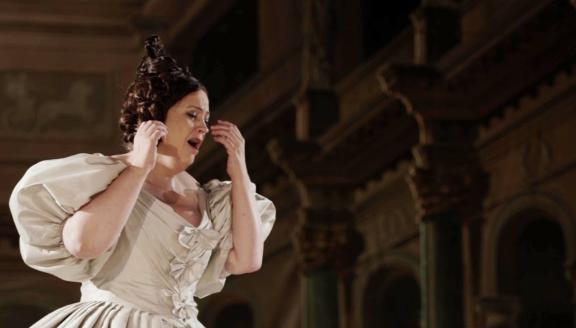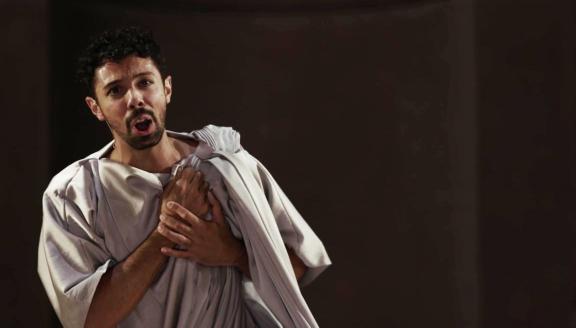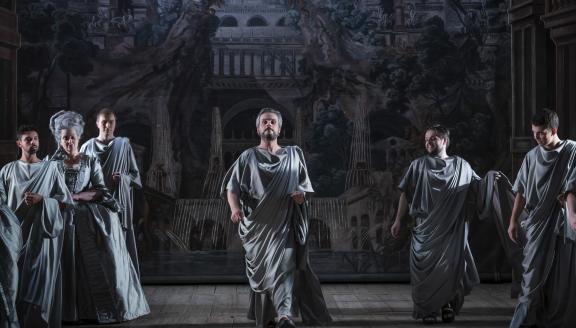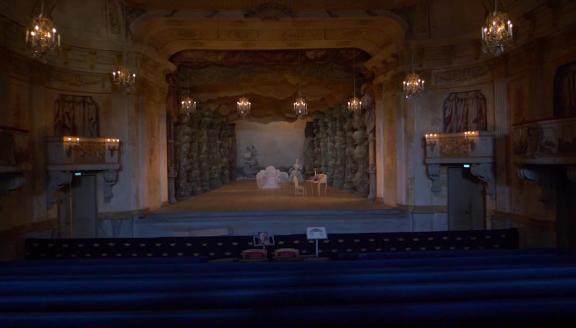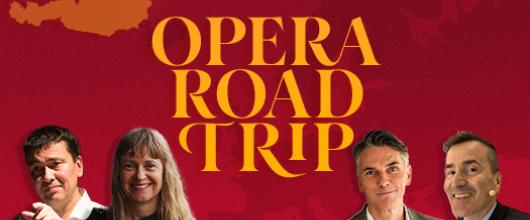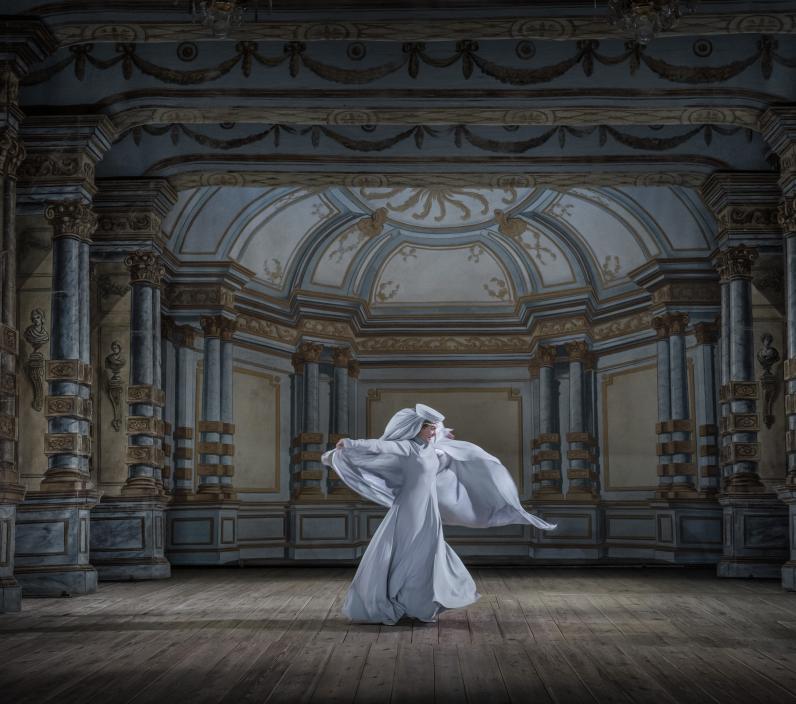
Agrippina

With her husband apparently drowned at sea, a scheming empress secures the throne for her son from another marriage. But the commander of the army has other ideas, and then the emperor returns, very much alive.
Drottningholm Palace Theatre (Drottningholms slottsteater in Swedish), located at Drottningholm Palace in Stockholm, is one of the few 18th century theatres in Europe that is still used as a theatre with original stage machinery. The beautiful rococo backdrop is the starting point for this production of Agrippina. Bente Lykke Møller’s costumes and scenery place the male characters in grey togas, alongside Agrippina and Poppea, who travel through the centuries in women's fashion (in discreet colours, with make-up and wigs by Sofia Ranow). This journey stops before the present day, perhaps leaving audiences to bridge the gap between the scheming heroine and figures in today’s world. If not political, director Staffan Valdemar Holm's production is certainly comic, built around the egomania of one of opera’s most outrageous leading women, sung by Sweden star mezzo-soprano, Ann Hallenberg. The young Handel packed Agrippina with the full range of his astonishing imagination, setting a libretto at once hilarious, moving and clever. The Italian conductor and harpsichordist Francesco Corti, a regular collaborator of the orchestras Les Musiciens du Louvre and Il Pomo d'Oro, presides over Handel’s music which is bursting with originality and fun, as well as carefully considered moments of great beauty.
Cast
|
Claudio
|
Nahuel Di Pierro
|
|---|---|
|
Agrippina
|
Ann Hallenberg
|
|
Nerone
|
Bruno de Sá
|
|
Poppea
|
Roberta Mameli
|
|
Ottone
|
Kristina Hammarström
|
|
Pallante
|
Giacomo Nanni
|
|
Narciso
|
Kacper Szelążek
|
|
Lesbo
|
Mikael Horned
|
|
Orchestra
|
Drottningholm Theatre Orchestra
|
| ... | |
|
Music
|
George Frideric Handel
|
|---|---|
|
Text
|
Vincenzo Grimani
|
|
Conductor
|
Francesco Corti
|
|
Director
|
Staffan Valdemar Holm
|
|
Sets and costumes
|
Bente Lykke Møller
|
|
Lighting
|
Torben Lendorph
|
|
Wigs and make-up
|
Sofia Ranow
|
| ... | |
Videos
Characters
AGRIPPINA: Wife of Claudio. Mother of Nerone. Wishes to see him as the next emperor of Rome, and plots for this to happen. Enlists the help of Pallante and Narciso.
CLAUDIO: Emperor of Rome. Married to Agrippina. Waged war in Britain, achieving glorious conquests, but was shipwrecked on the journey home. Believed first to have drowned but was rescued by Ottone. In love with Poppea.
NERONE: Son of Agrippina. Wishes to please his mother by becoming successor to Claudio as emperor. Fond of Poppea.
POPPEA: Young woman at the court. Longing for her beloved Ottone. When she realises the extent of Agrippina’s plotting, her desire for revenge grows.
OTTONE: Supreme commander of the Roman fleet. Saves Claudio’s life after he is shipwrecked and is promised the emperorship. Loves Poppea.
PALLANTE: Freed slave. Holds a high position in the senate as the secretary of the imperial treasury. Secretly in love with Agrippina.
NARCISO: Freed slave. Holds a position in the senate and is part of the court staff. Secretly in love with Agrippina.
LESBO: Slave and chamber servant to Claudio. Adores Poppea.
The libretto closely follows Roman history, and all characters, other than Lesbo, correspond to real historical figures.
Story
Act I
When her husband, the Roman emperor Claudio, has apparently drowned at sea, Agrippina plots for her son from a previous marriage, Nerone, to be Claudio’s successor. In fact, the emperor has been saved from death by the commander of the army, Ottone, and the imminent coronation of Nerone is abandoned. Ottone tells Agrippina that Claudio, in gratitude, has appointed him his successor. He also tells her that he, Ottone, has fallen in love with Poppea, and that he desires her more than he desires the throne. Agrippina, aware that Claudio also loves Poppea, sees a new opportunity of furthering her ambitions for Nerone. She goes to Poppea and tells her, falsely, that Ottone has struck a bargain with Claudio whereby he, Ottone , gains the throne but gives Poppea to Claudio. Agrippina advises Poppea to turn the tables on Ottone by telling the emperor that Ottone has ordered her to refuse Claudio's attentions. This, Agrippina believes, will make Claudio revoke his promise to Ottone of the throne.
Act II
Ottone is ready for his coronation but Claudio instead denounces him as a traitor. Devastated and bewildered, Ottone appeals to Agrippina, Poppea and Nerone for support, but they all reject him. Poppea is touched by her former beloved’s grief and begins to doubt his guilt. Eventually Ottone convinces her of his innocence and Poppea swears revenge, but she is distracted when Nerone comes forward and declares his love for her. Meanwhile, Agrippina convinces Claudio that Ottone is still plotting to take the throne and advises him to abdicate in favour of Nerone. Claudio agrees, believing that this will enable him to win Poppea.
Act III
While Ottone and Nerone hide in her bedroom, Poppea explains to Claudio that he had earlier misunderstood her: it was not Ottone but Nerone who had ordered her to reject his attentions. Claudio angrily dismisses his stepson. Nerone informs his mother of Poppea's treachery and of his decision to renounce love for political ambition. Agrippina confronts Claudio, berates him for succumbing to Poppea's influence, and claims that Ottone loves Poppea, thereby forcing Claudio to summon all three of them. He announces that Nerone and Poppea will marry, and that Ottone shall have the throne. No one is satisfied with this arrangement, as their desires have all changed, so Claudio, in a spirit of reconciliation, reverses his judgement, giving Poppea to Ottone and the throne to Nerone.
Insights
Francesco Corti
The Conductor on Agrippina
From many points of view, Agrippina stands out in Handel’s operatic production. Its creation marks a fundamental moment in the composer’s youth years. The successful reception of the opera after its première in Venice in 1709 must have felt to the 24-year-old composer as the crowning moment to his Italian years. After his exploits at the Roman court, and in other aristocratic circles of the peninsula, Handel seals his success with a triumph at the Serenissima, one of Europe’s most competitive artistic markets.
He was in very good company for this adventure. Cardinal Vincenzo Grimani’s libretto is one of the best (if not the best) Handel ever had the chance to set to music. The whole piece is infused by a unique sense of dramatic urgency. From the first words Agrippina says, we are drawn into a frantic chain of events, pushed forward by the plottings orchestrated by the drama’s two female characters. The psychological complexity of Grimani’s personages and the intricate story must have stimulated the young composer – one could imagine a parallel between the successful relationship Handel/Grimani and Mozart/da Ponte.
Handel’s refined technical skills are clearly evident on the score. The three-act opera deploys an outstanding formal and stylistic variety and many influences can be discerned in the music. Handel regularly recurs to the technique of parody: he ‘borrows’ music from other composers or from his own earlier works adapting them to a new musical-dramatic context. We find pieces by Reinhard Keiser, Alessandro Scarlatti, Antonio Cesti, Johann Mattheson, and from earlier secular and sacred compositions by Handel himself. Some of these self-borrowings are particularly virtuosic: the aria ‘Ho un non so che nel cor’ in Act 1 is a literal quotation of both text and music from La Resurrezione. One can often discern a subtle sense of humour accompanying most of these citations.
The complexity of the characters is regularly reflected in specific choices by the composer. Very often the music will be ambiguous when the aria’s text underpins an evasive or equivocal state of mind of the personage that sings it. Nerone’s first aria ‘Col saggio tuo consiglio’ sounds to me as a mixture of contrasting feelings (Handel effectively depicts a young boy overwhelmed by the news he has just heard), as much as Poppea’s aria ‘Spera alma mia’ from Act 2. Some oddities in rhythmical structures and in text setting also seem to point toward a profound reading of the libretto (Poppea’s first aria, the irregular phrasing in Claudio’s arias…). In many ways, Handel works hand in hand with Grimani and his music greatly deepens the psychological intricacy of the drama.
Agrippina is for many reasons a watershed: it is Handel’s last work whose libretto is rooted in the 17th century tradition, his last Italian piece and his first mature opera. After Agrippina, he was certainly ready for new and bigger professional challenges. A subtle game of symmetry and balance, an overflowing display of musical talent and virtuosity, a dramatic tour de force, a turning point in Handel’s career. In the repertoire of baroque opera, Agrippina stands out as incredibly modern and speaks to us directly.
Gallery
